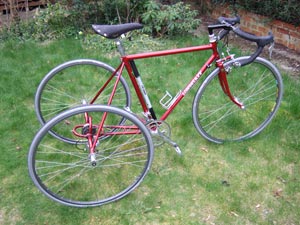 Ain’t she purty? |
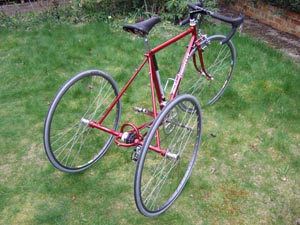 Three-quarters stance |
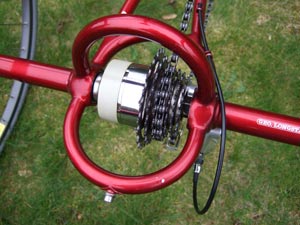 Longstaff double freewheel |
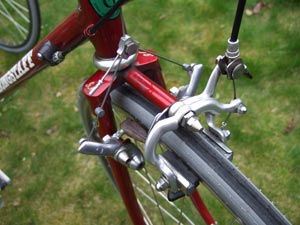 Twin front brake arrangement |
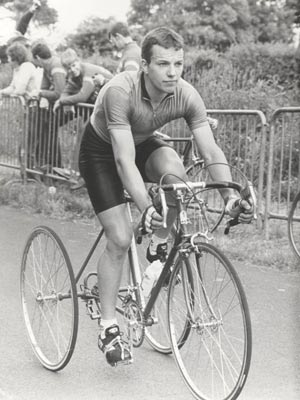 Back when tricyles ruled the roads… |
How much is enough ?(bikes, that is), asks Lars Engstrum on the RCUK forum. Who can say for sure? One thing’s for certain; no serious stable of cycles is complete without a trike. Note that this is not the same as saying no serious cyclist’s stable is complete without one; no serious cyclist would entertain the idea of riding one.
Having been a tricyclist in his youth, the author is hardly likely to fit that category and was therefore able without a qualm to leap at the chance to acquire one of these fabled machines.
The tricycle – or ‘barrow’ to the aficionado – in question is a George Longstaff Double Freewheel built about 10 years ago. George sadly died on a clubrun a few years ago but his invention, which allows either wheel to freewheel independently or bothto do so at once, inspired the thoroughly up to date www.trykit.com version based on a Shimano freehub body pattern. The Longstaff double, introduced in 1982, was built around a Maillard seven-speed ‘block’, which was the most reliable design available at the time.
For some reason, the double freewheel on its debut had as many detractors in the trike world as there were tricyclists unable or unwilling to come up with the purchase price of a new Longstaff.
The idea in fact makes complete sense. Racing trikes of the period mostly drove through the nearside wheel only, leaving the offside wheel to idle. This concept, introduced by Higgins of South Norwood, is light and, on a good, flattish road, effective. Throw in a loose surface or steep ascent, however, and traction may become a problem; if the driven wheel spins, you go nowhere. The same problem afflicts the differential drive, which was invented by James Starley in the late 19th Century for use on a tricycle and also perfected by Higgins for the modern machine.
In the case of the ‘diff’, both wheels drive simultaneously and, when cornering, at different rotating speeds. However, should one slip, it receives all the drive torque while the other does nothing, which is why performance cars employ a ‘limited slip’ differential.
The double freewheel is a better bet than either for cycle use, where braking torque need not be applied through either rear wheel. Since both can freewheel independently, the slower-rotating wheel provides drive while the faster wheel – on the outside of any bend – freewheels. Effectively, only one wheel is ever driving unless the machine is travelling in a dead-straight line.
The beauty of the idea comes when traction is at a premium, since the non-driven wheel only ever goes faster than the driven one. Therefore, on a loose surface the drive always goes to the wheel with traction – or to both. Eroica here we come.
The other feature of most solo trikes is the double front brake, permitted by act of parliament in this specific instance due both to the difficulty of fitting rear brakes and to the fact that they are not absolutely necessary since a front wheel skid will not usually cause a crash.
Is there any point? For sure; there are many reasons to ride a tricycle, some of them sensible and one or two serious. On the other hand, there are surely more reasons not to…but who cares?





